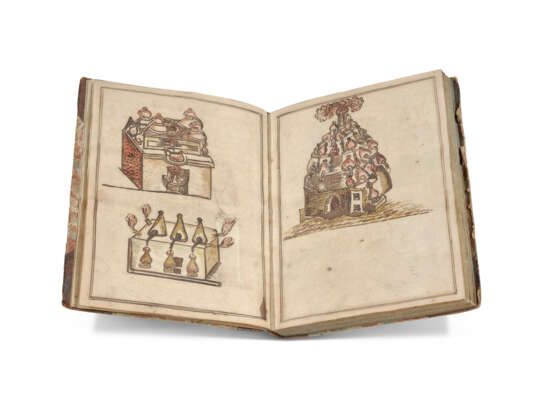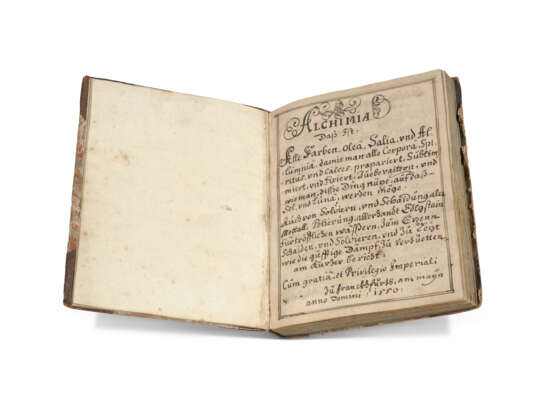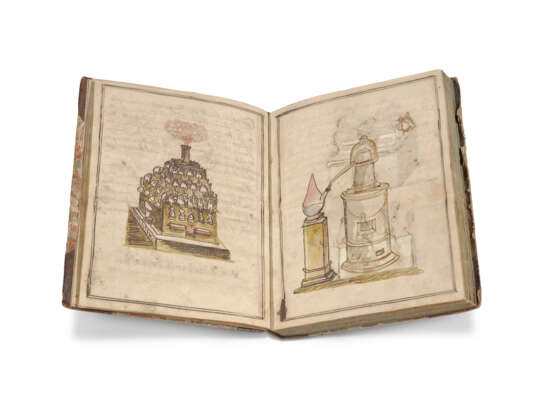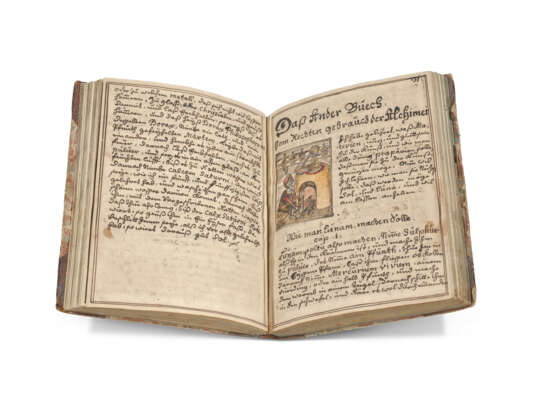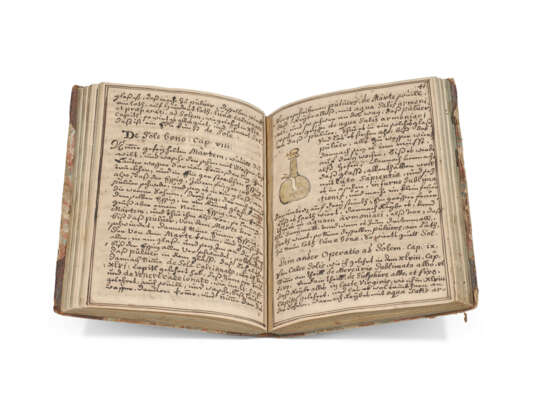ID 1349769
Lot 23 | Petrus Kerzenmacher
Estimate value
£ 6 000 – 9 000
Alchimia, in German, illustrated manuscript on paper, Frankfurt, 1550
'A porous boundary between alchemy and the world of mining': a rare copy of Petrus Kerzenmacher's practical alchemical booklet, with colour illustrations of furnaces and alchemical apparatus.
195 x 152mm. 108 leaves, complete, collation: 14 (of 6, i the upper pastedown and ii a cancelled blank), 2-912, 108 (of 10, ix a cancelled blank and x the lower pastedown), ff.i-x unnumbered, contemporary foliation 1-78 followed by modern foliation 79-98 followed here, c.25 lines of text within double frames, written space: 183 x 137mm, 7 full pages with 13 illustrations of alchemical apparatus and furnaces, 6 drawings of alchemists firing up furnaces and flasks accompanying the text (a few stains and smudges, a few crossings out, occasional show-through of text). ?17th-century quarter blind-tooled calf over marbled pasteboards (a little rubbed and scuffed).
Contents: Blanks ff.1-2v; Alchimia, Das ist: Alle Farben, Olea, Salia, und Allumnia [sic], damit man alle Corpora, Spiritus, und Calces, praepariert, Sublimiert, und Fixiert [...]: title-page and index of terms ff.i-i verso; author's preface, beginning: 'Petrus Koerzemnacher, etwann burger zu Maintz [...]' ff.ii-iii; coloured illustrations of furnaces and apparatus ff.iii verso - viii; Petrus Kerzenmacher, 'Rechter Gebrauch der Alchimei', chapters I-LXI, ff.1-30v; 'Das Ander Buech', chapters I-XXV, ff.31-59; Gilbertus Cardinalis, 'Kuenst alle Metall, zu Solvieren, beginning 'Nimb ein pfundt aluminis plumosi [...]' ff.59v-68; index ff.68v-69; added recipes for making gold, silver, antimony etc. beginning 'Nattuerliches Goldt, von dem Alchymistischen zu erkhenen', ff.70-78; blanks ff.78v-95v; a prayer and Psalm 90 ff.96-98.
Petrus Kerzenmacher's vanishingly rare work was written at a turning point in the state of alchemical theorising about the mineral world, at a time during which there was a ‘porous boundary between alchemy and the world of mining’ (M.A. Zuber, Spiritual Alchemy, 2021, p.15). It is an early, illustrated treatise on the practical applications of technological chemistry, including the manufacturing of colors, poisons and asphyxiating gases, delving into alchemical transmutation and separation of gold and silver. These technological artistic alchemical-scientific booklets, or Kunstbüchlein, dealing with alchemy, assaying and mining were popular in 16th-century Germany and had the very practical value of disseminating techniques in chemical processes to a wider audience. The first appearance of Kerzenmacher's treatise in its earliest form in print is anonymously with Christian Egenolff in 1531. It reappears more fully with Jacob Cammerlander in Strasbourg in 1534, where the author is named for the first time, and again in 1538 and 1539. The first Frankfurt edition does not appear until 1570.
The present manuscript is dated Frankfurt, 1550. It follows the 1538 Strasbourg edition closely, including the appended treatise of the alchemist Gilbertus Cardinal which deals with methods of putting metals into solution and the polishing of gemstones (a treatise that is also included in the 1534 and 1589 editions). The recipes added at the end do not seem to appear in any of the printed editions.
The full-page illustrations are on ff.iii verso - viii and the smaller illustrations are on ff.22v, 31, 32, 35, 41, and 59v.
| Place of origin: | Western Europe, Germany, Europe |
|---|---|
| Auction house category: | Medieval & renaissance manuscripts, Books and manuscripts |
| Place of origin: | Western Europe, Germany, Europe |
|---|---|
| Auction house category: | Medieval & renaissance manuscripts, Books and manuscripts |
| Address of auction |
CHRISTIE'S 8 King Street, St. James's SW1Y 6QT London United Kingdom | |
|---|---|---|
| Preview |
| |
| Phone | +44 (0)20 7839 9060 | |
| Buyer Premium | see on Website | |
| Conditions of purchase | Conditions of purchase |
